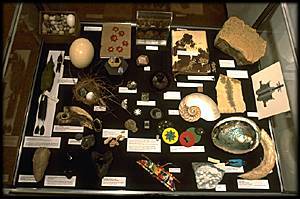|
|
The prize elements of any curiosity cabinets were its "curiosities": those things that were most unusual or bizarre. They might be prized for their rarity, or their association with a famous person, or because of their unlikely resemblance to other things, or because of the great skill with which they had been made. The abundance of objects within this small case creates a microcosm of the larger curiosity cabinet, re-presenting in miniature all of the ways in which objects might be associated with each other in the room at large. This micro-cabinet thus provides a key to the exhibition and to understanding the larger world it represents.
The variety of ways to compare objects in the micro-cabinet might include form, color, and function. Beginning with the bird eggs, we can see a number of shapes and sizes as well as examples of natural and artificial eggs. Real eggs can be compared to stone copies nesting in the bird's nest or to the plastic reproduction of a dinosaur egg. Also, the round shape of the eggs is echoed by the spiraling form of the nautilus shell and the circular shape of the abalone shell. The opalescent color of the abalone shell's interior resonates with some of the iridescent bird feathers included in the case. The hornbill, hand-ax, and fossilized tooth can be grouped together by function despite their varying materials and origins. These examples are intended to illustrate the nearly endless chain of connections a viewer might make within the context of a micro-cabinet or curiosity cabinet that were then carried over to the macrocosm.


